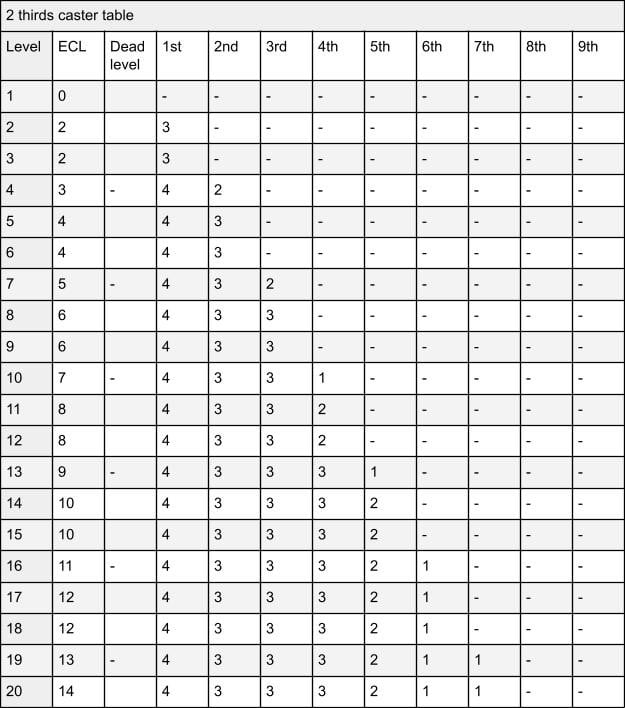“Dead” levels, casting, and balancing
Another article designed to help people homebrew in 5th edition.
When reading the players handbook or SRD you’ve probably noticed that each of the classes capable of casting spells have levels that there is nothing written in the “features” column of their class tables. You’ve probably heard this referred to as “dead levels” which, while not a very accurate name for it, is the common name and what I will be using for the rest of the article.
So why are there dead levels? And why do some classes have more of them than others?
The first one is easy, dead levels exist because gaining a new level of spell slot is considered a feature. After all, gaining a new level of spell slot is an increase in both number of options and power.
As for the second question. If you look closely, with only a few exceptions, the only times a caster gets a feature at the same time as a new level of spell slot is; when they gain their first level spell slot, when a feature they already have scales, and halfcasters at 5th level to scale their non-resource combat option. The exceptions are; artificer 9th level, bard 3rd level, cleric 17th level, arguably sorcerer 3rd level, and warlock 3rd level. While I do not have a clear idea why these exceptions exist as they do, they are indeed exceptions and it should be carefully considered whether or not an exception like this is appropriate for any class you design.
Exploring non-standard casting.
In 5th edition there are a few different kinds of casters each with their own purpose;
-
Third caster: for lightly supplementing a classes abilities, these are only used in official content as subclasses
-
Half caster: for an even blend of martial and casting prowess
-
Full caster: for a class that’s biggest feature is casting
-
Pact caster: for sustained but potent casting
With the variety available of proven kinds of casters it’s unlikely that you would need to venture from these to achieve the concept of a class, but maybe you do and that’s what we will explore from here.
Why use non-standard casting?
Maybe you are making a class that has a focus on casting but with an identity formed by abilities outside of casting, like the artificer, in this case you might use a half caster or even a third caster but round up at level one. Or maybe the class you are making has another substantial resource to track.
Whatever your reasons are it is important to keep in mind the following;
-
Fractional casters (third casters, half casters, or others) gain spellcasting at the level where their fraction becomes at least 1. After they gain spellcasting, their spellcasting levels (consult the multiclassing rules) are rounded up rather than rounded down when not multiclassing. For a casting focused class or one that uses spell slots as it’s primary resource give spellcasting at level 1 and round up always.
-
A class should never achieve a higher level of casting than a full caster of equivalent level.
-
There is never a reason to have a caster be less than a third caster as it is low enough casting to not warrant any dead levels.
Not using fractional casting but still using a table that resembles a regular caster would make multi-classing rather difficult, so if you decide a on making a non-standard caster that doesn’t use fractional casting I would suggest making the resource that powers it not spell slots or to model it similarly to pact casting. In any case, if a class would gain a spell slot at the same or a later level than a third caster would then it should not be considered a strong enough feature to be the only feature gained that level.
sample tables for non-standard casting


I apologize for the time between my posts. life get's in the way of hobbies sometimes.
if there is any other subject you would like me to discuss then let me know ok?